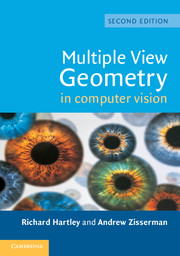Book contents
- Frontmatter
- Contents
- Foreword
- Preface
- 1 Introduction – a Tour of Multiple View Geometry
- PART 0 The Background: Projective Geometry, Transformations and Estimation
- PART I Camera Geometry and Single View Geometry
- PART II Two-View Geometry
- PART III Three-View Geometry
- PART IV N-View Geometry
- PART V Appendices
- Appendix 1 Tensor Notation
- Appendix 2 Gaussian (Normal) and χ2 Distributions
- Appendix 3 Parameter Estimation
- Appendix 4 Matrix Properties and Decompositions
- Appendix 5 Least-squares Minimization
- Appendix 6 Iterative Estimation Methods
- Appendix 7 Some Special Plane Projective Transformations
- Bibliography
- Index
Appendix 6 - Iterative Estimation Methods
Published online by Cambridge University Press: 25 January 2011
- Frontmatter
- Contents
- Foreword
- Preface
- 1 Introduction – a Tour of Multiple View Geometry
- PART 0 The Background: Projective Geometry, Transformations and Estimation
- PART I Camera Geometry and Single View Geometry
- PART II Two-View Geometry
- PART III Three-View Geometry
- PART IV N-View Geometry
- PART V Appendices
- Appendix 1 Tensor Notation
- Appendix 2 Gaussian (Normal) and χ2 Distributions
- Appendix 3 Parameter Estimation
- Appendix 4 Matrix Properties and Decompositions
- Appendix 5 Least-squares Minimization
- Appendix 6 Iterative Estimation Methods
- Appendix 7 Some Special Plane Projective Transformations
- Bibliography
- Index
Summary
In this appendix we describe the various components involved in building an efficient and robust iterative estimation algorithm.
We start with two of the most common iterative parameter minimization methods, namely Newton iteration (and the closely related Gauss-Newton method) and Levenberg–Marquardt iteration. The general idea of Newton iteration is familiar to most students of numerical methods as a way of finding the zeros of a function of a single variable. Its generalization to several variables and application to finding least-squares solutions rather than exact solutions to sets of equations is relatively straightforward. The Levenberg–Marquardt method is a simple variation on Newton iteration designed to provide faster convergence and regularization in the case of overparametrized problems. It may be seen as a hybrid between Newton iteration and a gradient descent method.
For the type of problem considered in this book, important reductions of computational complexity are obtained by dividing the set of parameters into two parts. The two parts generally consist of a set of parameters representing camera matrices or homographies, and a set of parameters representing points. This leads to a sparse structure to the problem that is described starting at section A6.3.
We discuss two further implementation issues – the choice of cost function, with respect to their robustness to outliers and convexity (section A6.8); and the parametrization of rotations, and homogeneous and constrained vectors (section A6.9). Finally, those readers who want to learn more about iterative techniques and bundle-adjustment are referred to [Triggs-00a] for more details.
- Type
- Chapter
- Information
- Multiple View Geometry in Computer Vision , pp. 597 - 627Publisher: Cambridge University PressPrint publication year: 2004
- 1
- Cited by



